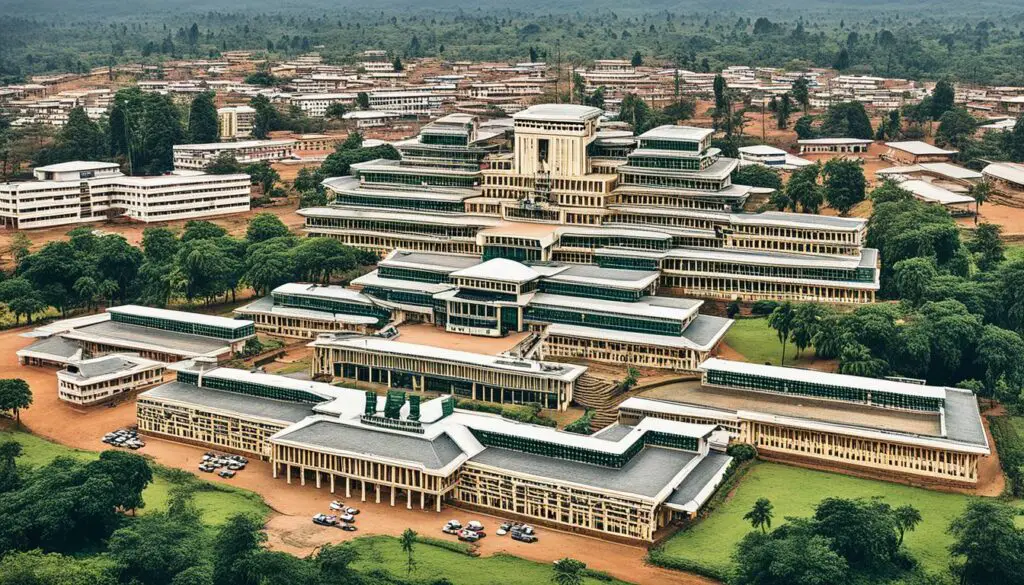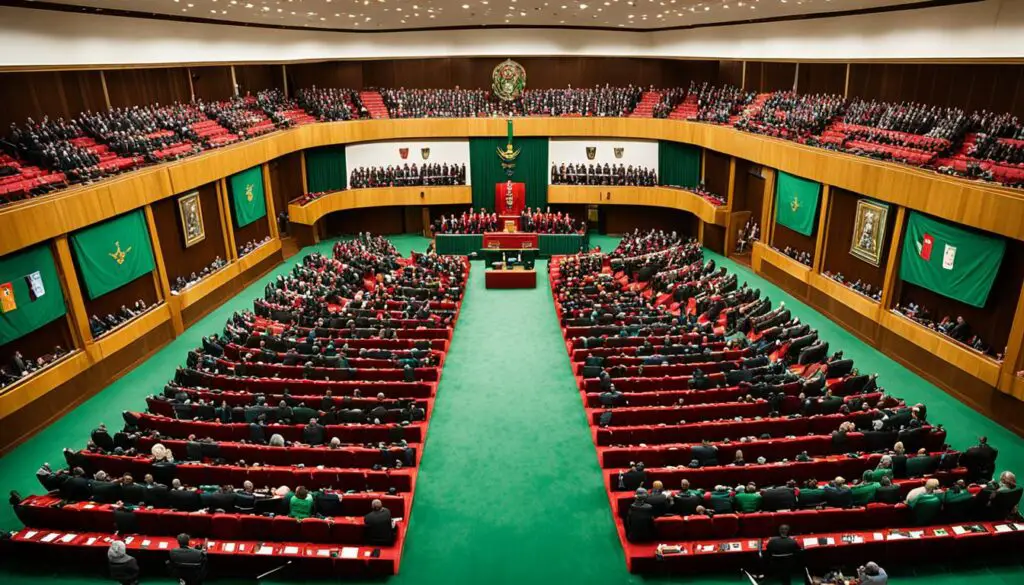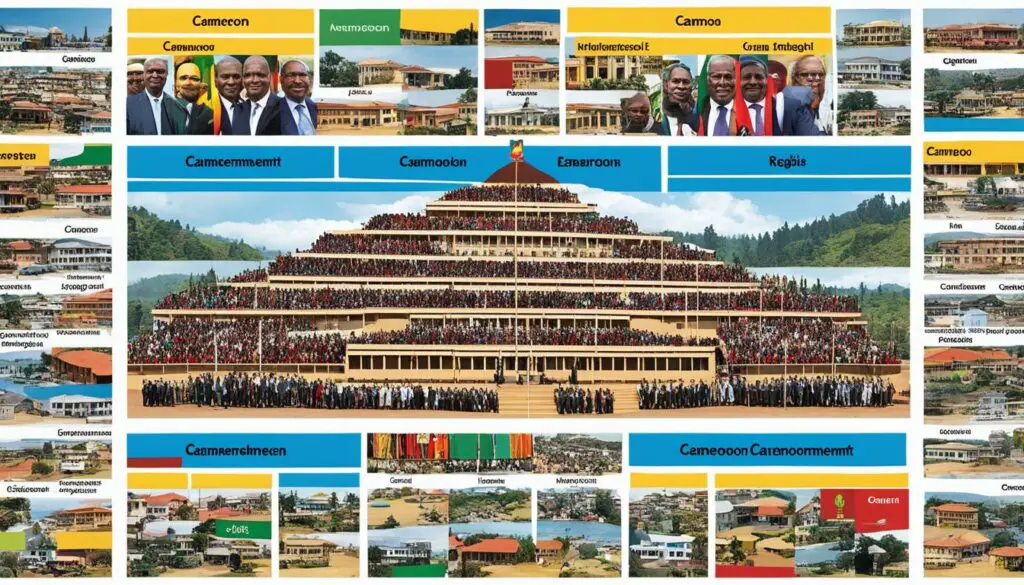Welcome to our comprehensive guide on the political framework and administrative structure of Cameroon. In this article, we will explore the Cameroon government type and provide insights into the country’s governance system. Understanding how the government operates is crucial for gaining a deeper understanding of the political landscape and administrative processes in Cameroon.
Key Takeaways:
- Cameroon has a diverse political framework and administrative structure.
- The government operates under a parliamentary system with multiple branches.
- The President serves as the head of state and leads the executive branch.
- The legislature consists of the National Assembly and the Senate.
- Cameroon’s judiciary plays a vital role in upholding the rule of law.
Cameroon’s Political System
When it comes to understanding the political system in Cameroon, it’s essential to explore its government structure and the branches of government that play vital roles in the country’s governance. With a focus on democratic principles and systems, Cameroon follows a multi-tiered political framework.
The political system in Cameroon is based on a semi-presidential republic, where the President serves as the head of state, leading the executive branch. The government structure consists of three distinct branches that work together to ensure the smooth functioning of the nation’s political landscape.

The Executive Branch
The executive branch, led by the President, is responsible for implementing and enforcing laws and policies. It holds significant decision-making power and oversees the day-to-day administration of the country. The President is elected by the people and serves as the head of state, representing Cameroon both domestically and internationally.
The Legislative Branch
The legislative branch in Cameroon is responsible for making laws and regulations. It consists of two chambers: the National Assembly and the Senate. Members of the National Assembly, representing the various constituencies, are elected by the people through a democratic process. The Senate represents regional interests and is composed of appointed members.
The Judicial Branch
The judicial branch maintains the rule of law in Cameroon. It ensures the fair and impartial interpretation and application of laws. The judiciary is independent and protects the rights and liberties of citizens. The Supreme Court is the highest judicial authority in the country.
By understanding the political system, government structure, and the branches of government in Cameroon, we gain invaluable insights into the country’s governance. In the next section, we will explore the role of the President and the executive branch in more detail.
The President and Executive Branch
In Cameroon, the President holds a crucial role as the head of state and leads the executive branch of the government. As the highest-ranking official in the country, the Cameroon President is tasked with numerous responsibilities, ensuring the smooth functioning of the government and implementing policies to drive the nation forward.

The President of Cameroon is both the head of state and the head of government. This means that they not only represent the country at the international level but also hold executive powers to make important decisions and enforce laws within the nation. The President is responsible for appointing members of the cabinet, who assist in the day-to-day governance and implementation of policies.
The Executive Branch, led by the President, consists of various ministries and governmental agencies that work together to address the needs and concerns of the Cameroonian people. This branch plays a crucial role in formulating and implementing policies, managing the economy, and maintaining national security.
As the head of state, the Cameroon President also represents the country in diplomatic relations, negotiating treaties, and fostering international partnerships. They play a significant role in promoting Cameroon’s interests on the global stage and ensuring its position as a respected member of the international community.
The President’s tenure in Cameroon is typically limited to two terms of seven years each. This ensures democratic governance and allows for the continuous infusion of new ideas and leadership within the executive branch. The transition of power through regular elections is a vital aspect of Cameroon’s political system, ensuring accountability and maintaining the democratic principles on which the nation is built.
The Legislature and Parliamentary System
In Cameroon, the government operates under a parliamentary system, where the Legislature plays a crucial role in the country’s governance. The Legislature consists of two chambers – the National Assembly and the Senate.
Functions of the National Assembly
The National Assembly, also known as the Lower House, is responsible for representing the people of Cameroon and enacting laws. It consists of members who are elected through a general election and serve for a term of five years. The National Assembly is instrumental in debating and passing legislation, overseeing government activities, and representing the interests of the citizens.
Composition of the Senate
The Senate, also known as the Upper House, represents the regional interests of Cameroon. It is composed of members who are appointed by the President of Cameroon, the country’s regions, and traditional rulers. The Senate plays a crucial role in ensuring regional representation and safeguarding the interests of different areas within the country.
To ensure a balance of power, the National Assembly and the Senate work together to govern Cameroon effectively. They collaborate on legislative matters and form a robust framework for decision-making and policy implementation.

Understanding the functioning and composition of the Cameroon legislature is essential to comprehending the country’s political landscape and how decisions are made. The National Assembly and the Senate work in unison to shape laws, policies, and initiatives that steer the nation towards progress and development.
The Judiciary and Legal System
In Cameroon, the judiciary and legal system play a critical role in upholding the rule of law and ensuring justice for all. Understanding the structure of the court system and the importance of the legal framework is essential for comprehending the country’s governance.
The Cameroon judiciary consists of multiple levels, each with its specific jurisdiction. At the top is the Supreme Court, which serves as the highest judicial authority in the country. It ensures the uniform interpretation and application of the law throughout Cameroon.
Beneath the Supreme Court, there are several other courts, including the Constitutional Council, which oversees matters related to the constitutionality of laws and elections. The Court of Appeals handles appeals against decisions reached by lower courts, while the High Court deals with serious criminal and civil cases.
The lower courts consist of the Magistrate Courts, which handle general civil and criminal matters, and the traditional or customary courts, which address disputes based on traditional and customary laws.
The legal system in Cameroon is a blend of civil law, customary law, and elements of English common law due to the country’s historical background. This combination provides a unique legal framework that reflects the diverse cultural heritage of the nation.
The rule of law is of utmost importance in Cameroon’s legal system. It ensures that laws are enforced, rights are protected, and justice is accessible to all citizens. The judiciary plays a crucial role in safeguarding the rule of law by ensuring fair trials, impartial judgments, and adherence to legal procedures.
With a well-functioning judiciary and a robust legal system, Cameroon strives to uphold justice, maintain order, and protect the rights of its citizens.
Regional and Local Government
One of the key components of Cameroon’s administrative structure is the involvement of regional and local government. With a focus on decentralization, the regional and local government plays a vital role in governance and decision-making processes.
The regional government in Cameroon is responsible for overseeing and coordinating the development and welfare of the specific regions within the country. It ensures that the needs and interests of the local communities are addressed effectively, allowing for greater regional autonomy.
At the local level, the local government plays a crucial role in providing essential services and infrastructure to the communities. This includes areas such as education, healthcare, transportation, and public safety. The local government also acts as a link between the central government and the local communities, ensuring that their concerns and perspectives are heard and considered.
This system of decentralization is aimed at promoting participatory governance and ensuring that decision-making processes are inclusive and representative. By empowering the regions and local communities, the government aims to foster development, enhance service delivery, and promote grassroots involvement in decision-making.
The administrative divisions within Cameroon are structured in a way that supports regional and local government functions. These divisions provide a framework for efficient coordination and administration, enabling effective implementation of policies and programs at the regional and local levels.
Overall, the regional and local government in Cameroon play a vital role in ensuring effective governance, decentralization, and the development of the country as a whole.

Political Parties and Elections
In Cameroon, political parties play a crucial role in shaping the country’s democratic process. They serve as platforms for citizens to express their political ideologies, participate in elections, and influence the governance of the nation.
Cameroon is a multi-party system, with several registered political parties vying for power and representation. These parties have different ideologies, goals, and strategies, creating a diverse political landscape.
During elections, political parties in Cameroon compete for seats in the National Assembly, the lower house of the legislature, and other elected positions. The electoral system follows a proportional representation method, allowing parties to secure seats in accordance with their share of the popular vote.

The Democratic Process
The democratic process in Cameroon involves the active participation of political parties and their supporters. Citizens have the right to vote and choose their preferred political party and candidates. Elections are conducted periodically to ensure a peaceful transfer of power and give citizens the opportunity to select their representatives.
Political parties engage in campaign activities, such as rallies, debates, and grassroots mobilization, to garner support and educate voters about their priorities and policies. They also play a crucial role in advocating for the interests of their members and constituents.
Elections in Cameroon are supervised by the election management body, Elections Cameroon (ELECAM), which ensures fairness and transparency throughout the electoral process. ELECAM is responsible for voter registration, organizing elections, and resolving any disputes or irregularities that may arise.
By participating in elections and supporting political parties, citizens contribute to the democratic process and exercise their right to shape the future of their country.
Challenges and Reforms in Cameroon’s Government
The government of Cameroon faces various challenges that require careful consideration and proactive reforms. These challenges impact governance, political stability, and accountability within the country.
Governance Reforms
One of the significant challenges in the Cameroon government is the need for governance reforms. These reforms aim to improve the efficiency, transparency, and effectiveness of government operations. By implementing reforms, the government can strengthen its administrative processes, enhance public service delivery, and foster public trust.
Political Stability
Political stability is crucial for the long-term development and prosperity of any nation. In Cameroon, ensuring political stability remains a pressing challenge. By promoting inclusive political dialogue, fostering a culture of peaceful coexistence, and addressing the concerns of various stakeholders, the government can work towards creating a stable political environment.
Accountability
Enhancing accountability within the government is another critical challenge. The citizens of Cameroon rightly expect their leaders to act in their best interests and be held accountable for their actions. By implementing mechanisms for transparency, strengthening anti-corruption measures, and promoting a culture of accountability, the government can build trust with its citizens and promote good governance.
Conclusion
In conclusion, understanding the Cameroon government type is crucial for gaining insights into the country’s political landscape and administrative structure. Throughout this article, we have explored various aspects of Cameroon’s governance, including its political system, branches of government, and the roles of key institutions.
By delving into the President and Executive Branch, we have discovered the significance of the President as the head of state and leader of the executive branch. Additionally, we have examined the legislature and parliamentary system, where the National Assembly and Senate play essential roles in shaping legislation.
The judiciary and legal system in Cameroon have been addressed, emphasizing the importance of the court system and the rule of law. Furthermore, we have explored regional and local government structures, highlighting decentralization and the administrative divisions that contribute to effective governance.
Lastly, we have discussed political parties and elections, shedding light on the diverse political landscape in Cameroon and the democratic processes that shape governance. We have also acknowledged the challenges faced by the government and the potential for reforms to ensure political stability and promote accountability.
By comprehending the Cameroon government type, individuals can gain valuable insights into the complexity of its political framework and administrative structure. It enables a deeper understanding of how power is distributed, decisions are made, and the country is governed. Whether for academic, professional, or personal reasons, exploring the governance system in Cameroon is essential for anyone interested in the country’s political landscape.
FAQ
What is the government type in Cameroon?
Cameroon operates under a semi-presidential republic government type.
What is the political system in Cameroon?
The political system in Cameroon is a multi-party system with a parliament and executive presidency.
Who is the President in Cameroon?
The President of Cameroon is the head of state and leads the executive branch of government.
How does the legislature work in Cameroon?
Cameroon’s legislature operates under a parliamentary system and is comprised of the National Assembly and the Senate.
What is the judiciary system like in Cameroon?
Cameroon’s judiciary is composed of a hierarchical structure of courts, ensuring the rule of law in the country.
What is the role of regional and local government in Cameroon?
Regional and local governments play an essential role in Cameroon, contributing to decentralization and managing administrative divisions.
How do political parties and elections work in Cameroon?
Cameroon has a diverse political party landscape, and elections are held to ensure a democratic process in the country.
What are some challenges facing Cameroon’s government?
Cameroon’s government faces challenges such as governance reforms, political stability, and ensuring accountability.